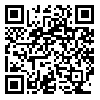BibTeX | RIS | EndNote | Medlars | ProCite | Reference Manager | RefWorks
Send citation to:
URL: http://zanko.muk.ac.ir/article-1-133-en.html
Background and Aim: Obsessive-Compulsive Disorder (OCD) is a neurological disorder characterized by irrational fears and thoughts to repeat some behavior that makes people, so the aim of present research is investigation of the effect of the thoughts control and the fusion of thought and action with obsession symptoms in non-clinical population.
Materials and Methods: The present study was descriptive and of correlation studies' type. For this purpose, 230 students (130 girls and 100 boys) from University of Semnan in the academic year 2013-14 were selected by stratified random sampling method. The instruments of research as the questionnaire of the thought control, fusion of thought and action as well as the questionnaire of obsession symptoms were supplemented. Pearson’s correlation and stepwise multiple regression methods were used for data analysis.
Results: The Pearson’s correlation results show that there is significantly negative relation (P<0.01) between the components of the thought fusion and obsession symptoms. In addition, there is merely a significant relation between obsession symptoms and social control (r=0.26 & P<0.01) through the component of the thought control. The results of step by step regression show 19% of the variance of obsession symptoms is determined by the variables of the social control, fusion of thought and action as well as the distraction.
Conclusion: Finally, the results of this research show the determination of the variance of obsession symptoms is significantly related to the variables of the social control, fusion of thought and action as well as the distraction which we can use them to improve the obsession symptoms for students.
Received: 2016/08/3 | Accepted: 2016/08/10 | ePublished: 2016/09/27
| Rights and permissions | |
 |
This work is licensed under a Creative Commons Attribution-NonCommercial 4.0 International License. |



